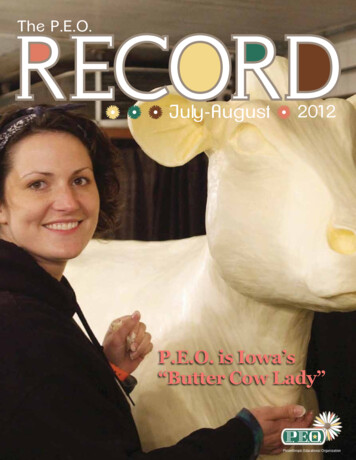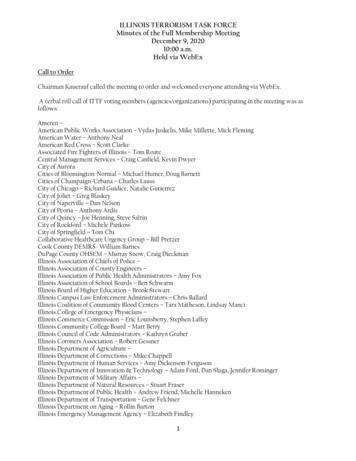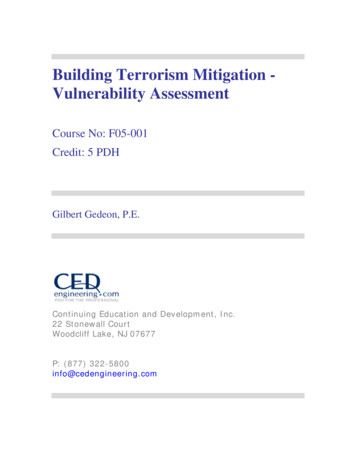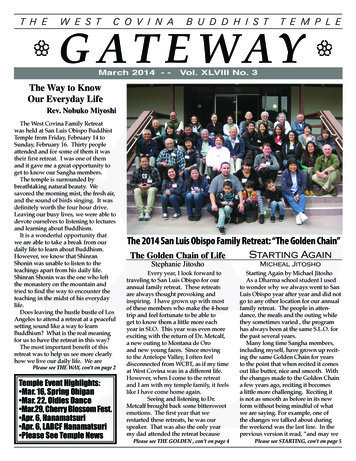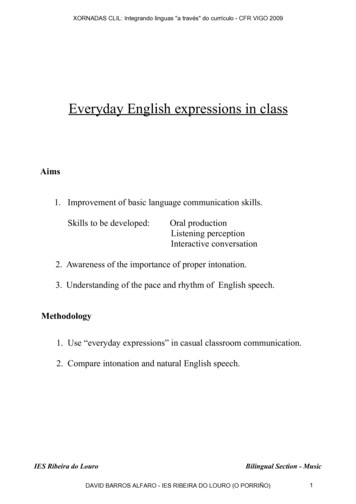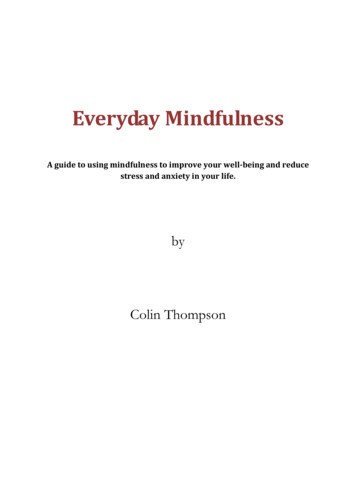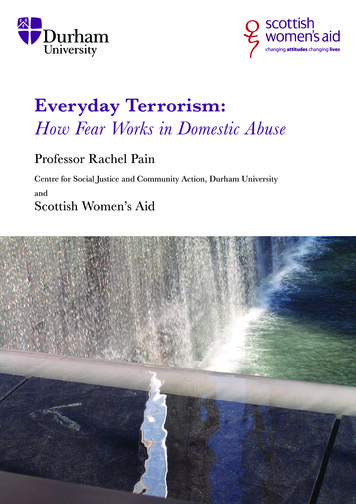
Transcription
Everyday Terrorism:How Fear Works in Domestic AbuseProfessor Rachel PainCentre for Social Justice and Community Action, Durham UniversityandScottish Women’s AidCentre for Social Justiceand Community Action
Everyday Terrorism:How Fear Works in Domestic Abuse
Everyday Terrorism: How Fear Works in Domestic AbuseContentsAcknowledgements .Summary .Introduction .Methodology .1. The feeling of fear .1.1 Terror: fear in the moment1.2 Chronic fear: “Treading on eggshells”1.3 Entrapment: physical and social isolation1.4 Fear of leaving: “If I’m scared of him now.”2. How fear works .2.1 Fear and control2.2 The abusers voice2.3 Doublethink: “It made me feel I was going crazy”2.4 Doing the emotional housework2.5 Layers of constraint: social inequality and fear3. Fear for Children .3.1 Children as victims and witnesses3.2 The deliberate use of children in partner abuse3.3 Give me a reason4. Finding security: Strength and Fear .4.1 Mixed feelings4.2 Strength and resisting domestic abuse4.3 Critical moments5. After Separation: Fear, Trauma and Restoration .5.1 Fear as a result of continuing abuse5.2 Trauma: the effects of chronic fear5.3 Restoration: living with and past fearConclusions .References .568910142022252829AcknowledgementsWe are very grateful to the women and men who shared their experiences of fear and domesticabuse for this research. We would also like to acknowledge the help of staff working fororganisations providing services to people experiencing domestic abuse in Scotland, who assisted inarranging interviews.Rachel would like to thank Lucy Berrington, Peter Hopkins, Lynn Staeheli, Lynne Bargewell, DotKirkham and Tamlynn Fleetwood for their help and support during the research.This research was funded by a British Academic Small Research Grant (SG111095).5
Everyday Terrorism: How Fear Works in Domestic AbuseSummaryAimThis report presents the findings of research conducted in 2012 by the Centre for Social Justiceand Community Action at Durham University in collaboration with Scottish Womens Aid.While there have been improvements in recognition of the harm that domestic abuse causes, it isstill quite poorly understood in wider society and among some service providers. A question stillcommonly asked is: why don’t people who are being abused in intimate relationships simply leave?In answer to this, this research focuses on the fear that is experienced by adults suffering domesticabuse. It aims to explore the multi-faceted nature and effects of fear.MethodologyThe methodology included a wide-ranging literature review of existing research on fear, domesticabuse and national/international terrorism, and 18 in-depth qualitative interviews with 16 survivorsof domestic abuse. They included women and men who are heterosexual, gay and lesbian, as well asmigrant and non-migrant women.The research investigated:how fear operates both in the immediate moment of abusive incidents and in the long term,the ways in which domestic abuse entraps people through fear,how children are implicated in this process,how people being abused resist and manage both abuse and fear,how fear relates to other emotions,the role of emotions in resistance and the long process by which some of those who areabused become survivors.Key findingsThe research suggests that domestic abuse can be considered a form of everyday terrorism. It createslong-lasting fear and trauma, which reinforce the abuser’s control over the abused person. It affectsvastly greater numbers of people than global terrorism, and it has impacts on many aspects ofsociety as well as on the individual.The frequency and prolonged nature of domestic abuse, the psychological aspects of this control,and the setting in which domestic abuse takes place all help to explain these higher levels of fear andtrauma.The research demonstrates that:1.Fear in situations of domestic abuse is distinctive: Being abused in a domestic setting, by an intimate partner, shapes the nature of theimmediate fear during violent incidents. It also leads to chronic fear which builds up over thelong term and leads to significant trauma and negative effects on health and wellbeing. The social and physical entrapment and isolation which often accompanies abuse reinforcethese fears, and make help-seeking more difficult. Fear is often a key reason for not leaving, and this fear is rational and justified.2. The psychological and emotional control that result from fear are a key way in which domesticabuse ‘works’: Keeping another person in a state of chronic fear does not require physical violence to beused all of the time, or at all. Using and playing on fear is common by abusers, and is made possible because of theirintimate knowledge of the person they are abusing.6
Everyday Terrorism: How Fear Works in Domestic Abuse Abusers tell powerful stories about the abuse to the person they are abusing, often saying itis the fault of the person being abused. Many interviewees experience a state of ‘doublethink’as a result.Gender roles within intimate relationships – in other words, who it is who usually does thedomestic and emotional work - make abuse easier to perpetrate and harder to escape.Other social inequalities, especially those of sexual orientation, income, class, ethnicity,migrant status and disability, can also increase fear of domestic abuse and its effects.All of these factors explain why it is so difficult for people who are abused to leave.3. Concern for children is central to the fears of many people who experience domestic abuse: Children are sometimes victimised by the abusive parent, and frequently witness abuse. Children are sometimes deliberately used in one parent’s abuse of another. Children are often a key reason for the parent being abused not leaving, as well aseventually being a key reason for leaving. This apparently contradictory situation is explainedby the complex and risky nature of the decision to leave.4. People experiencing domestic abuse are not passive victims, but take many actions to improvetheir security: Considerable strength and courage are required to live with domestic abuse, and theseemotions are experienced alongside fear. Those interviewed tried to resist and manage abuse and fear in different ways. While love of their partner turned to dislike or hate once abuse became established, manystill feel some sense of duty and responsibility and some try to ‘fix’ the abuse. Humiliation andshame at being abused are also powerful emotions for some. All interviewees describe a critical moment, a major or minor event which precipitates anemotional shift in fear/strength which had been building for a long time. Often this helpedthem to eventually separate from the abusive partner.5. After separation, fear often continues. Recovery and restoration are long processes: Abuse often continues after separation, and leads to continuing or heightened fear. Trauma, an effect of chronic fear, may fully surface only after separation from the abuser. All interviewees also describe positive outcomes of separation for themselves and their children.7
Everyday Terrorism: How Fear Works in Domestic AbuseIntroduction“Domestic abuse is the mental, physical and/or sexual abuse by a partner or ex-partner. In most cases, it is experiencedby women and children, and is perpetrated by men. Domestic abuse is often serious and sustained and can be lifethreatening.” (Scottish Womens Aid, 2008)Domestic abuse is a widespread, everyday phenomenon in higher and lower income countriesalike, that cuts across boundaries of class, age, race, ethnicity and sexual orientation (McCue,2008). A widely cited review of European studies suggests that around one in four women experiencedomestic abuse over their lifetime, and between 6-10% in any given year (Council of Europe, 2002).Domestic abuse does not only consist of acts of violence, although these are often present. It alsocommonly includes a range of tactics including threats, isolation, and undermining self confidenceand self esteem. The severity of its impacts rest on the common operation of fear, terror and control(Dobash and Dobash, 1979; Johnson 2008; Stark, 2007). Domestic abuse is marked by its repeatedand long-term nature: a large UK study showed that the average number of incidents per year was20 for women and seven for men (Walby and Allen, 2004).The overall theme of this report is to draw a parallel between domestic abuse and terrorism (see alsoHammer 2002; Herman 1997; Johnson 2008; Phillips 2008). Framing domestic abuse as ‘everydayterrorism’ helps to understand how fear works. It highlights the frequency and severity of domesticabuse, the serious effects of the fear that it invokes, and the control that this fear makes possible(Dobash and Dobash 1992; Stark 2007). Drawing this parallel also muddies the boundaries betweenforms of violence that are usually framed as public, political and spectacular, and forms of violencethat are usually framed as private, apolitical and mundane.Terrorism at national and global scales is more widely recognised as an attempt to impose order andcontrol through violence and fear (Flint and Radil, 2009; Goodwin, 2006; Onuf, 2009):Terrorism is violence used in order to create fear; but it is aimed at creating fear in order that the fear, in turn,will.accomplish whatever it is that the terrorist really desires (Fromkin, 1975, 692-3).Recent terrorist attacks on the west are increasingly global in scale, spectacular in nature, anddesigned to maximise fear (Flint and Radil, 2009). Indeed, having these wider effects on public andstate fears is seen as the main intention in the current ‘fourth wave’ of terrorism (Rapoport, 2004).Interestingly, however, evidence from research on recent instances of global terrorism suggests thatwhile incidents cause great trauma for those caught up in them, they are relatively ineffective atcreating wider fear (Pain 2010; Rapin 2009).Domestic abuse, on the other hand, directly terrorises people who are abused and their children; itis a way in which abusers exert psychological and emotional control, and it often leads to changes tobehaviour among those who are abused. Most of all, domestic abuse, like global terrorism, can beseen as part of a desire to gain or enforce particular forms of political control. Its effects reinforce thesocial and political structures that produce it. In the case of domestic abuse, the most important ofthese is gender inequality, and this report also discusses inequalities of social class, sexual orientation,ethnicity, migrant status, and disability. So domestic abuse, and the corrosive effects of the fears ofthose who suffer it, are not simply an issue of individual or family conflict – they relate to, and issustained by, social inequalities at the level of society.Domestic abuse, then, can be considered a more effective form of terrorism – it routinely createslong-lasting fear and trauma, and affects vastly greater numbers of people than global terrorism. Asthe accounts of those interviewed for this research show, the frequency, prolonged nature and settingin which domestic abuse takes place all help to explain and justify these higher levels of fear andtrauma. Naming domestic abuse ‘terrorism’ is not to suggest that the two forms of violence are the8
Everyday Terrorism: How Fear Works in Domestic Abusesame, but they have a shared basis as attempts to exert fear and control.However, there are huge differences in recognition of, and levels of response to, ‘private’ and ‘public’forms of violence. Because of the intimate nature of domestic abuse, the costs associated with itare less visible and so less well recognised. But, for example, domestic abuse has been estimated tocost the Scottish economy 2.3 billion (Scottish Government 2009). At this point in time, there isa growing imbalance in resourcing that the two terrorisms receive, and this urgently needs to beaddressed (see also Phillips 2008). Indeed, the current context in western countries has seen brutalcuts to the provision of services for those being abused and for survivors (Baird, 2012; Fine 2012;Scottish Womens Aid, 2011; Towers and Walby 2012; Women’s Aid, 2012), as well as re-emergingpolitical contestations over domestic abuse (Doll 2012) - all in stark comparison to the resourcingand attention given to global security issues (Phillips, 2008). The 2011 Scottish Womens Aid censusshowed that on the one census day, refuge space could not be found for 20 women and 15 childrenand young people, or one in three of those requesting it.While there have been improvements in recognition of the harm that domestic abuse causes, it isstill quite poorly understood in wider society. A question still commonly asked is: why don’t peoplewho are being abused in intimate relationships simply leave? In answer to this, the research reportedhere focuses on the fear that is experienced by those suffering it. There has been relatively little indepth research on exactly how this fear feels, or how it works in different situations of abuse. Thisreport concentrates on how fear operates both in the immediate moment of abusive incidents and inthe long term; how abuse entraps people through fear; how children are implicated and used in thisprocess; how those suffering fear of abuse resist and manage both abuse and fear; how fear relatesto other emotions; and the role of fear, strength and resistance in the long process by which some ofthose who are abused become survivors.MethodologyThe methodology for the research included:(i) A wide-ranging literature review of existing research on fear, domestic abuse and national/international terrorism (see Pain 2012),(ii) Qualitative interviews.Between January and June 2012, 18 in-depth qualitative interviews were conducted with 16 survivorsof domestic abuse, who documented experiences of abuse in 18 intimate relationships. All exceptthree were living in Edinburgh or Fife at the time of the interview. They were recruited throughorganisations that provide services to people experiencing domestic abuse, and personal contacts.The sample included 14 women and 2 men. One woman and one man talked about samesex relationships. Interviewees ranged in age from 25 to 65, and came from varied social classbackgrounds. 13 interviewees were from white ethnic backgrounds, and three had ethnic minoritybackgrounds and had migrated to Scotland as adults. All but three of those interviewed had youngchildren at the time of the abuse.The interviews were conducted by Rachel Pain and lasted between one and three hours. They werelightly structured and in-depth, allowing for a balance between the interviewer’s questions and theinterviewee’s preferences in telling their stories, and allowed new themes to emerge. The topicsincluded the early days of the relationship, the onset and development of abuse, the interviewees’feelings about the abuse, their responses to the abuse, how they came out of the relationship, andwhat happened subsequently.9
Everyday Terrorism: How Fear Works in Domestic AbuseInterviews were transcribed and subject to standard qualitative analysis procedures. Any names andplaces mentioned were changed to preserve anonymity, and interviewees were offered the option ofchoosing a pseudonym for themselves.1. The feeling of fearThis section describes the feeling of fear in domestic abuse, both during abusive incidents and inthe longer term between their occurrence. It outlines how physical and social entrapment canreinforce these fears. It explains why the prospect of leaving often creates further fear, however muchthe person being abused may want to leave.1.1 Terror: fear in the momentThis sub-section identifies the fear experienced during incidents of physical violence. The abuseexperienced by interviewees comprised a combination of some or all of physical, sexual, psychologicaland emotional abuse. However, almost all had suffered some physical violence as part of the abuse,and while this was often described as ‘not the worst part’ of the abuse in comparison to less visibleaspects (Williamson 2010, and Section 2), it invoked a great deal of fear.All of the women and men interviewed describe traumatic feelings of fear during violence and justafter it. Domestic abuse often becomes far more routine than, for example, abuse between strangerson the street; but incidents of violence remain a shock, often experienced as coming ‘out of theblue’. Interviewees describe both physical shock, and a feeling of betrayal of the expectation of trustand care in intimate relationships which they describe as the hardest to come to terms with. Whilepeople who are abused adopt skills of precaution and management to try and maintain security forthemselves and their children, domestic abuse is not something that you “get used to”. The fear andtrauma that interviewees talk about continue, and often intensify, over months or years.Jennifer: With him he would just blow, right, and it could be out of the blue, the first thing is shock, youknow, and it’s like it’s a physical shock, I mean it’s like you know you are walking down the street andyou see someone hit by a bus or you know something terrible happens. It’s like you stand there and youcan’t believe, you cannot believe that this is happening.Meghan: He had his hands round my neck there and he just basically he was punching me about, andthen he sort of got up off of me, and he was like “are you afraid?” and I was like I thought “what the helldo I say?”.but I mean I was, I just was physically shaking because you just dinnae ken what’s going tohappen next.Candy: I would actually physically start shaking or stutter because I was trying to say something to him and he would laugh about that, he would be like you know “what are you shaking at?” and then just startlaughing, and then because he saw that side he knew that anything he did would just frighten me.Kate: The feelings you know I remember when he was sort of screaming at me and we were in the middleof one of these scenes which were so horrifying, he would you know I would have these, I would feel thecascade of hormones you know, this kind of heat it was hot or cold or something but I could just feel itmoving through me you know as your body kind of tries to cope. it’s such a sort of intensity of stresshormones and I remember just thinking this is so toxic for my body and then I was pregnant of coursetoo.the sort of physical sensation of anger and fear and distress and how intense that was.All of the interviewees describe this mix of physical and psychological reactions. Fear in the momentof violence is an affective bodily experience, at the same time as it is a cognitive one: panic has tobe suppressed, as the mind is working fast to try to plan how to halt or minimise the damage of theincident:10
Everyday Terrorism: How Fear Works in Domestic AbuseJennifer: There’s this sort of rational part of your head that starts doing a commentary on the situationyou know, and one of the immediate things for me is “where are the children?”, right so and if thechildren are in the same room then I need to get Philip out of that room, I have to do whatever I can toget him out of the room and away from the children, and you know if the children are downstairs then Ineed to get Philip into the bedroom and I need to really work on quietening him down, and then I also Ineed to go downstairs, I need to reassure the children.Because of this need to manage and cope in the immediate moment, especially where children arepresent (Section 3), sometimes the full psychological trauma caused by particular incidents is notfully experienced until after the relationship has ended (see Section 5). Nonetheless, the immediateresponses of those abused, like Jennifer, are highly rational.Consciousness of what is happening on the part of the abuser also seems to be commonplace fromthe interviewees’ accounts. As Candy’s description (above) illustrates, although abusers may appearto be out of control, and they may explain abuse in this way afterwards, they are often able to drawback if someone else is present (though they rarely do this if it is only children who are present –Section 3) or to taunt the person they are abusing. In this way, fear is not an unintentional effect ofabuse, but something that abusers may recognise, play on and use:Kim: When I was defending myself he’ll come to me and hug me. I didn’t understand at that timebecause then he will fight and then he will come to calm me down and hug me.I was just so confused.Rachel: So did he calm down at the moment when you defended yourself?Kim: Yes, yes.like he was having this smile.because he was winning.People who are being abused often feel great humiliation at the powerlessness of their position, andthis is the case whether the abuse is physical, sexual, psychological, emotional or a combination. Fora number of the women interviewed, the shock and effects on self esteem were also greater as – incontrast to common images of those who suffer domestic abuse as weak - they saw themselves asstrong women:Kim: I felt hopeless, shocked, again like powerless. I was this woman in control of her own life, I thoughtso, and here he was treating me as someone with no importance.I wasn’t prepared because I wasscared, yes, far away from everybody.1.2 Chronic fear: “Treading on eggshells”This sub-section returns to abuse in all its forms. The majority of those interviewed suffered abusefor many years. Over time, domestic abuse creates an emotional and psychological state quite uniqueamongst crimes: chronic fear. Judith Herman’s (1997) classic account of trauma links the experiencesof survivors of violent atrocities including torture, concentration camps and family violence. Sheargues that complex trauma arises from a setting from which escape is difficult, and a perpetratorwho may appear ‘normal’.Interviewees talk about their feelings of fear in between incidents (which may take place daily, ormay be weeks apart). As time goes on, this chronic fear escalates, as they come to inhabit an almostconstant dread of abuse and develop detailed precautions to try and ensure their security. Severalused the metaphor of treading on eggshells to describe this state:Ellie: When he came home from his work I was treading on eggshells and everything . I felt terrible, Ifelt sick every time he came in from his work is he going to be pleased or is he going to come in in abad mood? Am I going to get battered the night again or, everything’s just going through your mind and11
Everyday Terrorism: How Fear Works in Domestic Abuseyour stomach goes absolutely, you feel sick.Kate: Being exposed intimately to a crazy person is very scary.I was always on eggshells. I mean Iremember thinking this was like living in a house where, you know, say I’m walking around a room andthere are particular points on the floor where I’m going to get an electric shock, and I never could knowwhere those spots were.Emma: It feels like everything goes out of control and you’re trying to pull everything back into, youknow, like all these wee eggs into this one wee basket to try and keep it in tight so that it doesn’t fly offthe handle again, do you know what I mean? So you’re constantly on edge. So I’m not eating properly.and that’s how I lived.All of those interviewed took sometimes elaborate precautions, and changed many aspects of theirbehaviour to try and avoid abuse. This is not to say that they did not resist the abuse (Section 4).There is also a feeling among those interviewed, with hindsight, that while they felt vital at the timeto security, precautions are in one sense fruitless: they did not seem to increase security or reducefear. Margie likens the feeling of chronic anxiety to a coiled spring; again a lot of effort is put intotrying to predict what might trigger abusive behaviour, and taking action to avoid abuse:Margie: It would come out of nowhere you know I’d be. like a spring coiled up, that’s how I felt thewhole time in the chest because I didn’t know when something like this was going to happen. It was atightness the whole time inside my chest. I was never relaxed, I was always tense that something couldhappen.Candy: It’s just to feel that fear before someone comes in, and then you know be really on edge thewhole time that he’s actually around until the time that he’s fast asleep in bed, it’s just I don’t know howto describe it, it’s really it’s just it’s horrible, you’ve got a knot in your stomach the whole time and you justyou know you’re like “oh my God is this going to make him go or is this going to make him go?”As is well documented, this state of chronic fear and associated stress has serious impacts on physicaland mental health (Herman 1997; Lundgren et al 2002; Scottish Womens Aid 2010b, 2010c).Interviewees reported a whole range of symptoms while experiencing abusive including anxiety,depression, sleep problems, low self esteem, self-harming and thoughts of suicide (see also Section5):Petunia: I ended up with stomach ulcers because I was internalising all of this. like I noticed if somebodytapped me on the shoulder, I practically just, I didn’t realise I was on fight or flight all the time, I couldn’tjust unwind.Cheryl: I felt as if it was like, to be honest I felt as if I’d been like sometimes, as in it wasnae worth livingany more.1.3 Entrapment: physical and social isolationReinforcing this state of chronic fear, domestic abuse is often marked by the gradual withdrawalof those suffering it from spaces outside the home, and from family and friends (Bowstead 2011;Warrington, 2001). This varies considerably between abusive situations, depending on circumstancesand the form of the abuse taking place. However, most interviewees in this study say that they werephysically entrapped to some degree: prevented by the abuser from going out, or contacting friends,or having their movements and interactions subject to great scrutiny (Stark 2007):Bobbie: I ended up isolating myself from all my friends, never went out or anything, because it didnaematter where I went he was on the phone eh, “when are you coming back?” and he was really controllingover me.12
Everyday Terrorism: How Fear Works in Domestic AbuseCandy: He stopped me talking to my family, I wasn’t allowed to go out of the house, I wasn’t allowed tomeet anybody, you know I had no contact with anyone outside the house at all. He had a mobile andI had one to begin with when I was with him but he broke it so I didn’t have any other phone.I wasbasically a prisoner.Margie: After we’d moved over here he kept me a prisoner.he wouldn’t let me go out because if I wentout I’d spend money.Petunia: It was actually one of her family members who shocked me into realising how much I’d changed.and it was then that I realised how much I had kowtowed to keep the peace. I didn’t really believe inmyself that it was wrong to speak to people, but I did alter my behaviour.Entrapment is a result of fear, because of the threat of abuse when the abusers ‘rules’ are broken.It also compounds chronic fear - physical and social isolation heighten the self-doubt that oftenresults from abuse (Section 2), and it also means that getting support from family and friends isless likely. None of the interviewees told anyone about the abuse when it began, and several wentfor many years without divulging it to anyone. Entrapment, then, like fear, is both a physical and apsychological state.Cheryl: I just needed somebody to, I felt as if I needed something physical to remove me from thesituation. I used to lie in my bed at night and like actually think “how can I actually get out of here?” like,do you know what I mean, it’s just it’s a horrible situation to be in.Contact with formal support agencies is also made more difficult by physical and social isolation(Ptacek 1999). For some of those interviewed, it was workers in these agencies who were the firstpeople they told about the abuse (see Taylor et al, 2012). However, again, abusers may directly orindirectly intervene, using fear to make any help-seeking behaviour fraught with difficulty:Nina: Once I also phoned the health visitor just because I was so worried about my baby, I thought “if heharms the baby what will I do?” But when I phoned the health visitor he was there standing next to me,and then he was shouting, saying “now you know what I am really like, you are going to see what I’ll do toyou” and things like that. So I got so scared that I phoned the health visitor and said “please don’t cometo my house, everything’s fine now”.1.4 Fear of leaving: “If I’m scared of him now ”Fear is the main reason why people being abused do not leave. Some of those intervieweddesperatel
9 Everyday Terrorism: ow Fear orks in Domestic Abuse same, but they have a shared basis as attempts to exert fear and control. However, there are huge differences in recognit

